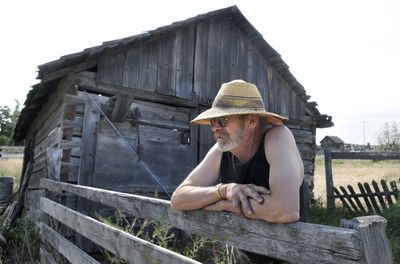Bassett home oldest in the county

The first home Wilbur Fisk Bassett built for his family in 1872 near Four Lakes burned down during a large grass fire two years later. He built his second cabin on the same spot in 1874 – and it remains today the oldest still-standing home in the county.
Historians are quick to point out that there is a structure at Fort Spokane, at the confluence of the Spokane and Columbia rivers, that is older. True, but that building was used for other purposes and was never an inhabited home – which leaves the Bassett home recognized as the oldest in the county.
The first cabin was made of round pine logs with mud chinking, which disintegrated, leaving holes through which sparks were able to reach the roof when fire swept the surrounding prairie, according to an account in “Fairchild, Heritage of the Spokane Plains” by Peggy Bal.
It also was the cabin that young Minnie Maria Bassett lived in. She was the first white child born in Spokan Falls, according to historical accounts, and drowned in the nearby Bassett Spring in the summer of 1873 when she was a year and a half old. Her gravesite in the fields nearby has been maintained by those who farmed the land since.
When pioneer Bassett rebuilt, he erected a more solid structure, using hand-hewn square logs which he meticulously dovetailed at the corners. The family moved away from there soon after. Around 1900 when a large barn and root cellar were built several hundred yards away on the opposite side of Granite Lake Road, the Bassett home was moved down the hill and situated in a field by the new barn. The granite stone fireplace did not make the move, and has long since disappeared.
As the building deteriorated, interest was taken in it by historian and schoolteacher Edmund T. Becher, author of “Spokane Corona, Eras and Empires.” In 1956 his Rogers High School history class put on a new shake roof. They also built a stone wall around Minnie Maria’s grave to help preserve it.
“You’d be surprised about that roof,” said Jerry Johnson, who farms the McMillan land on which the home is located. “You can see light through it this time of year, but it swells up in the winter and is still pretty watertight.”
Even so, time continues to take its toll. Johnson said the lower logs are beginning to pitch out and he’s taking steps to try to stabilize the structure. Anyone interested in lending a hand is invited to contact him at i90barnman@yahoo.com.
Long ago Minnie Maria’s brother, Herman Bassett, wrote about the cabin of his youth. For many years the publisher of the Harrington Citizen (he died in 1965), he was known as the Sagebrush Bard because of his many poems, one of which appeared in nearly every edition of his newspaper. A part of one poem, “The Bassett Fourlake Hewed-Log House,” reads:
“Twas built in Fourlake frontier times
When Dad was in his manhood’s prime
And placed upon that building site
That with the Pole star lined at night.
The trees required for this large room
Would number fifty, I presume,
Each tree was chosen for its worth –
Knot-free, straight grain, and heighth and girth.
With broadaxe every log was hewed
And to a chalkline mark was trued;
Its size was 12x24,
It had two windows and a door …”
Late each summer a party is held outside the building, when neighbors and friends gather to celebrate its history and the heritage of the region. And sometimes, people interested in Northwest history come and find Johnson to ask about the home.
“One time a four-car caravan of teachers from Missoula came by wanting to take a look,” Johnson said. “I asked them why they were interested in our history when there’s so much there in Montana. They told me they’d run out of Missoula history and were looking to expand their search.”
It remains a fascinating building. It no longer has the feel of a home, but it holds ample evidence of the life it took on when it was moved to its current site, when it was converted into a blacksmith shop. A pitchfork still waits for a new handle, harness pieces lie in need of mending, a broken hand pump sits on a table and broken shovels lie about. They’re right where they were left so very long ago.